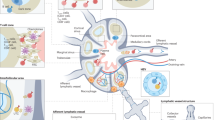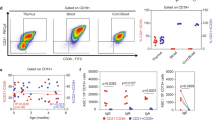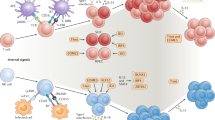Abstract
VERY little information is available concerning the origin of the lymphoid cells of human and animal leukaemias. The lymphoid cell population has been divided into two different functional groups, namely the thymus derived lymphocytes (T cells) mainly involved in cell mediated immunity, and the bone marrow derived lymphocytes (B cells) mediating humoral immunity. These two lymphocyte categories have not been distinguished morphologically, but several specific markers for their identification have been described. The thymus, brain and thymus derived lymphocytes (T cells) bear a cell surface isoantigen θ1 and have very little detectable immunoglobulin molecules on their surface; whereas the bone marrow derived lymphocytes (B cells) have a high density of immunoglobulin determinants on their surface2.
This is a preview of subscription content, access via your institution
Access options
Subscribe to this journal
Receive 51 print issues and online access
$199.00 per year
only $3.90 per issue
Buy this article
- Purchase on Springer Link
- Instant access to full article PDF
Prices may be subject to local taxes which are calculated during checkout
Similar content being viewed by others
References
Raff, M. C., and Wortis, H. H., Immunology, 18, 931 (1970).
Raff, M. C., Sternberg, M., and Taylor, R. B., Nature, 225, 553 (1970).
Johanson, B., and Klein, E., Clin. Exp. Immunol., 6, 421 (1970).
Wilson, J. D., and Nossal, G. J. V., Lancet, ii, 788 (1971).
Grey, H. M., Rabellino, G., Pirofsky, B., and Mnanue, E., J. Clin. Invest., 50, 40 (1971).
Klein, E., Klein, G., Nadkarni, J. D., Nadkarni, J. J., Wigzell, H., and Clifford, P., Cancer Res., 28, 1300 (1968).
Shevach, E. M., Ellman, L., Davie, J. M., and Green, I., Blood, 39, 1 (1972).
Kaplan, H. S., Cancer Res., 27, 1325 (1967).
Haran-Ghera, N., Kotler, M., and Meshorer, A. J., Nat. Cancer Inst., 39, 653 (1967).
Haran-Ghera, N., and Kotler, M., Bibl. Haematol., 31, 70 (1968).
Miller, J. F. A. P., and Mitchell, G. F., Transpl. Rev., 1, 3 (1969).
Haran-Ghera, N., Int. J. Cancer, 1, 81 (1966).
Haran-Ghera, N., Israel J. Med. Sci., 7, 17 (1971).
Reif, A. E., and Allen, J. M. V., J. Exp. Med., 120, 413 (1964).
Möller, G., J. Exp. Med., 117, 415 (1961).
Shevach, E. M., Herberman, R., Lieberman, R., Frank, M. M., and Green, L., J. Immunol., 108, 325 (1972).
Author information
Authors and Affiliations
Rights and permissions
About this article
Cite this article
HARAN-GHERA, N., PELED, A. Thymus and Bone Marrow Derived Lymphatic Leukaemia in Mice. Nature 241, 396–398 (1973). https://doi.org/10.1038/241396a0
Received:
Issue Date:
DOI: https://doi.org/10.1038/241396a0
This article is cited by
-
A cell-surface molecule involved in organ-specific homing of lymphocytes
Nature (1983)
-
Hemopoietic stem cells and target cells in murine-virus-induced leukemias
Journal of Cancer Research and Clinical Oncology (1982)
-
Structural features and selective expression of three Ly-5+ cell-surface molecules
Immunogenetics (1981)
-
Spontaneous murine B-cell leukaemia
Nature (1978)
-
The effect of dimethylbenz(a)anthracene on murine hematopoiesis
Zeitschrift f�r Krebsforschung und Klinische Onkologie (1977)
Comments
By submitting a comment you agree to abide by our Terms and Community Guidelines. If you find something abusive or that does not comply with our terms or guidelines please flag it as inappropriate.



